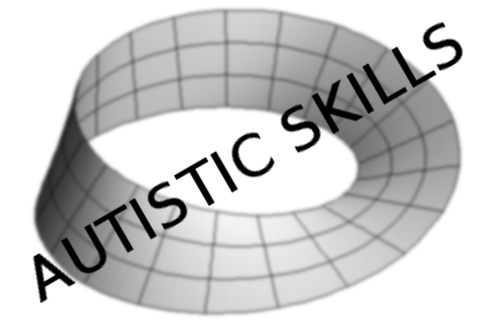

Non-autistic thinking perceives itself as something whole, it lives within language and uses an entire universe of historically grown concepts in order to understand itself and the world, and in order to communicate with others.
Workshops "autistic skills" are workshops to learn anything about autism. Your own experiences meet those of other autistic people. Differently to non-autistic peoples experiences they are comparable so that your own experiences caqn mirror themselves in those of the others. That's a suitable basis fr researching autistic thinking, the own as well as that of other humans.
Once I started to deal with philosophy as a juvenile I realised that "normal" thinking relies basicly on language. But my thinking has two different modes which are differ a lot from each other; though I can change between them. One of this modes is a lingual mode which is structuring and analytical - far away from emotions and meanings. The other one is perception based, perception without items, a continuing flow of forms, colours and sounds. They overlap seamlessly, change from moment to moment and are connected to each other by associative networks, colours with sounds, forms with smells and so on. My language based thinking picks up single aspects out of this torrent of perception and links them with terms. This way it creates a world of objects and meanings. I know it because I know the mental state where language based thinking ceases to funktion and where I find myself within a torrent of forms, colours and sounds which no more build items or objects. Then I'm not within this torrent but part of it. Thinking in two modes overcharged me until I learned how to deal with it in a proper manner - with help of my mathematical studies. Before I had the impression of living in both worlds only half done - I regarded my thinking as deficit. Since then I experience living in two worlds as enrichment of my life.
Menwhile I met more than thousand autistic people of differnet kinds, about 800 in more zhan 120 workshops "autistic skills" which I moderated. Within tese workshops I made the experience that the ways of autistic thinking differs a lot from each other; it makes up an entire spectrum. Both, non-autistic and autistic thinking, I regard as a spectrum, the autistic one far broader than the non-autistic one. I suppose, both spectra don't overlap each other but are very close to each other. Autistic thinking types differ from each other depending on which perception channels contribute which aspects, how they are connected to each other, if associative or analytic thinking comes to the fore and much more. In spite of these differences the spectrum can be clustered to thinkingtypes - where each cluster is a spectrum by itself. These clusters arise by theselves only due to experiences where there are moments showing common patterns again and again. My experiences suit well to neurobiological indications which focus on interconnections in brains: areas of perception processing are interconnected more densly with each other and more loosely with areas of language processing (and motor functions): separated thinking.
Due to my experiences with my perception based thinking it is organised in a associtive way. The perceived things make up networks of connections on the basis of similarities; similarities of forms, colours, sounds and alike. This network is not fixed but dynamic in a high degree, it changes in each moment. Like never ending cascades those loosely connected perceptional items float away. I'm sure that all autistic people know this kind of thinking. I'm in fact unsure if all autistic humans perceive this as consciously as I do, bur I'm sure every autistic humans can access their perception based thinking consciouesly. This certainty I got from my workshop experiences. Lingual thinking is based on concepts, structures which permanently transform changing perceptional attractions to fixed objects. It is analytical and self-contained: It shows a self-contained world of objects and a self-concluded individuum which shows as "I". Perception based thinking is always open, there is no discrimination bewteen inside and outside: the own "self" appears blurred as part of the perceived. Language builds a network of interrelated meanings which lays as a fixed structure above the ever changing network of perception associations. While autistic humans as separated thinkers can perceive their network of perception based associations for entangled thinkers this network dissembles behind a language based reality.
Our workshop experiences are characterised by the fact that the partcipants treat each other open-minded, value-free, interested and reflectiing - if they perceive the communication setting as safe. Safe means safe from missunderstandings, interpretations hidden (but subtly perceivable) purposes and irritations. These prepositions given they are open for each other in a double sense: open to be read of the others and open to record what the others give them to read. This way autistic humans are able to exchange their experiences and to integrate other (autistic) humans experiences into their experiences. Something which is really hard to achieve within another (non-autistic) environment of communication. Like the conversations the exchange of experiences is widely organised in an associative way. They relate to the thinking of the participants. Within an associative communication environment this kind of thinking can connect to that of the others. The openness and open-mindedness of the workshops show that autistic humans don't perceive themselves as individuals with well-defined boundaries. In the associative structured conversations you can recognise their direct access to their perception based thinking.